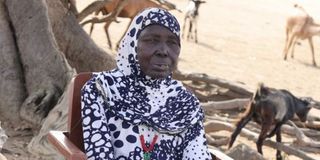Hey AI, what bit me? Doctors turn to technology to treat lethal snakebites

Apuk Bak, a snakebite survivor, during the interview at her home in Mayen Abun–Twic County, South Sudan
What you need to know:
- In Kenya, snakebites kill approximately 4,000 people annually while an estimated 7,000 others experience paralysis or other health complications.
In the sun-scorched plains of Mayen Abun-Twic County in South Sudan, Apuk Bak sits on a woven mat outside her house, absently rubbing scars on her leg- a lifelong reminder of a cruel snakebite. Her eyes drift to the horizon, recalling the day the snake struck. Apuk, then aged seven, was herding her parents’ cattle when a black mamba bit her. The venom spread rapidly, leaving her unconscious and permanently disabled.

Awar Deng, a clinical officer at Mayen Abun Hospital in South Sudan sensitises the community about snake envenoming.
Her family, which did not have access to proper medical care, turned to traditional remedies—raw eggs and herbs—which failed to stop the venom’s destruction. “They gave me a raw egg and some herbs, thinking I would vomit the poison. My leg swelled up fast, and I couldn’t move. Then I lost consciousness.”
Decades later, at 76, Apuk still bears the physical and psychological scars of that fateful day. “The disability has affected me physically and mentally,” she admits. “I can’t walk long distances or do heavy chores. I feel like I am ageing faster because of the snakebite. If I had accessed the right antivenom back then, maybe I wouldn’t be like this,” she says.
Her story isn’t unique in Mayen Abun, where tales of snakebites weave through family histories like threads in a tapestry.
In South Sudan, danger slithers unseen. Black mambas, puff adders, and cobras coil in tall grass, their venom a silent assassin that has haunted rural communities like Mayen Abun for generations.
Snakebites disproportionately affect rural, impoverished communities in South Sudan and Kenya, where medical care is scarce, leading to thousands of deaths and permanent disabilities. In South Sudan, floods and conflict exacerbate the problem by driving snakes into human settlements.
For too long, the odds of survival have hinged on a near-impossible task: identifying the type of snake fast enough to deliver the right antivenom.
The deaths
In remote villages across East Africa, the difference between life and death often hinges on a single question: which snake?
The World Health Organization (WHO) classifies snakebite envenoming as a Neglected Tropical Disease, disproportionately affecting the poor in remote areas where medical help is scarce. Globally, five million people suffer snakebites annually, with two million facing severe consequences such as limb loss, internal bleeding, or death.
In sub-Saharan Africa, the toll is staggering. According to WHO, between 81,000 and 138,000 people die each year from snakebites, with many more suffering long-term disabilities. South Sudan is particularly vulnerable as floods drive snakes into human settlements, while conflict further isolates communities from healthcare facilities.
In these areas, diagnosing the snake responsible for a bite is often a guessing game, with limited medical knowledge leading to ineffective treatment.
But all is not doom and gloom.
Now, in South Sudan's flood-prone plains, artificial intelligence (AI) is rewriting this deadly equation, transforming snakebite care in communities.
A collaboration between Médecins Sans Frontières (MSF) and the University of Geneva is turning smartphones into life-saving tools. The AI system, trained on thousands of snake images and venom profiles, allows healthcare workers to instantly identify venomous species and administer the correct antivenom.
The technology works offline, making it ideal for remote locations with limited internet access. Early trials at Mayen Abun Hospital show that this innovation has reduced treatment delays by 30 per cent, significantly improving survival rates and reducing complications such as amputations.
South Sudan’s snakebite crisis isn’t random, it’s a collision of geography, climate, and human hardship. Twic County’s sprawling grasslands and seasonal rivers are a haven for reptiles. “From May to June, when people cultivate and weed their farms, snake bites spike,” says Awar Deng, a clinical officer at Mayen Abun Hospital. He has seen the pattern year after year - rainy seasons flood snake burrows, driving them into villages and fields.
“They’re looking for dry grounds, and we are in their way.”

Lamu County KWS Senior Warden Mathias Mwavita acknowledged he had received reports about the snake invasion.
Awar notes that AI is mainly used to identify the snake species that are living in South Sudan, particularly Twic County where MSF is operating. “AI helps to identify venomous and non-venomous snakes. By quickly identifying the exact species responsible for a bite, the system ensures that the correct antivenom is administered, preventing amputations and deaths.”
The impact of this AI-driven approach extends beyond South Sudan. In the neighbouring Kenya, snakebites kill approximately 4,000 people annually while an estimated 7,000 others experience paralysis or other health complications, according to the Kenya Snakebite Research and Intervention Centre.
The centre is working with global partners to develop AI tools tailored to the country’s unique snake species. These efforts aim to improve the accuracy of snake identification, streamline antivenom distribution, and reduce reliance on expensive imported treatments.
Dr Gabriel Alcoba, a medical advisor at MSF Switzerland, is one of the brains behind it. “The idea was to bridge a gap,” he says via a Zoom call from Geneva. “Traditional identification relies on rare expertise or blind luck. We partnered with engineers to build an algorithm that learns from photos—hundreds at first, then thousands.”
The AI was trained on a sprawling dataset: snake images from across Africa, paired with venom profiles and clinical outcomes. “We tested it, refined it, and now it’s over 85 per cent accurate—and getting smarter,” he adds. In early trials at Mayen Abun Hospital, the system has already cut treatment delays by 30 per cent, slashing the risk of mismatched antivenoms.
The tech’s brilliance lies in its adaptability. In South Sudan’s remote pockets, where the internet is a luxury, it works offline, storing data until a signal is found. Real-time monitoring tracks patient recovery, alerting staff to complications like kidney failure or necrosis. “Smartphone coverage is growing, even here,” Gabriel notes.
For a health worker like Awar, AI is a lifeline. “A farmer comes in and says he was bitten in the field. We take a picture, and boom—puff adder. We grab the vial and go.”
At Mayen Abun Hospital, the AI’s impact is tangible. Survival rates are climbing, and amputations are dropping. “We are intervening faster. Previously, a patient could lose a leg. But now we are able to save it. Community trust is growing too. They see it works, and that’s what changes minds,” says Awar.
By integrating AI into snakebite response strategies, Kenya and the broader East African region stand to benefit immensely. Faster diagnosis means quicker treatment, lower mortality rates, and reduced long-term disabilities. Additionally, AI-driven mapping of snake populations can inform better prevention strategies, protecting communities before bites occur.
For survivors like Apuk, this technological breakthrough is bittersweet—a solution that came too late for her but holds the promise of saving thousands of lives. In a world where technology often serves luxury and convenience, this innovation stands as a beacon of hope, proving that scientific advancements can reach the most remote corners of the world, turning tragedy into triumph and fear into survival.



